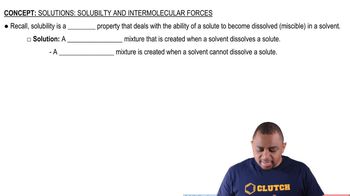For the dissolution of LiCl in water, ∆Hsoln = -37 kJ/mol. Which term would you expect to be the largest negative number: ∆Hsolvent, ∆Hsolute, or ∆Hmix?
Ch.13 - Properties of Solutions
Chapter 13, Problem 21b
Two nonpolar organic liquids, hexane (C6H14) and heptane (C7H16), are mixed. (b) Hexane and heptane are miscible with each other in all proportions. In making a solution of them, is the entropy of the system increased, decreased, or close to zero, compared to the separate pure liquids?
 Verified step by step guidance
Verified step by step guidance1
Understand that entropy is a measure of disorder or randomness in a system.
Recognize that mixing two substances generally increases the entropy of the system because the molecules are more randomly distributed.
Consider that both hexane and heptane are nonpolar organic liquids, which means they have similar intermolecular forces and are miscible in all proportions.
When hexane and heptane are mixed, the system becomes more disordered as the molecules of each liquid are distributed throughout the mixture.
Conclude that the entropy of the system increases when hexane and heptane are mixed, compared to when they are separate pure liquids.

Verified video answer for a similar problem:
This video solution was recommended by our tutors as helpful for the problem above.
Video duration:
1mWas this helpful?
Key Concepts
Here are the essential concepts you must grasp in order to answer the question correctly.
Entropy
Entropy is a measure of the disorder or randomness in a system. In thermodynamics, it quantifies the number of ways a system can be arranged, with higher entropy indicating greater disorder. When two substances mix, such as hexane and heptane, the overall disorder of the system typically increases, leading to a higher entropy state compared to the separate pure liquids.
Recommended video:
Guided course

Entropy in Thermodynamics
Miscibility
Miscibility refers to the ability of two substances to mix in all proportions without separating into different phases. Hexane and heptane are both nonpolar organic liquids, which allows them to mix completely. This property is crucial in understanding how the mixing of these liquids affects the system's entropy, as miscible liquids tend to increase disorder upon mixing.
Recommended video:
Guided course

Solubility and Mixtures
Thermodynamic Favorability
Thermodynamic favorability relates to the tendency of a process to occur spontaneously based on changes in energy and entropy. When hexane and heptane mix, the increase in entropy generally makes the mixing process thermodynamically favorable. This means that the system's overall energy state is lowered, and the process is likely to occur naturally, contributing to the increase in entropy.
Recommended video:
Guided course

First Law of Thermodynamics
Related Practice
Textbook Question
Textbook Question
Two nonpolar organic liquids, hexane (C6H14) and heptane (C7H16), are mixed. (a) Do you expect ∆Hsoln to be a large positive number, a large negative number, or close to zero? Explain.
Textbook Question
KBr is relatively soluble in water, yet its enthalpy of solution is + 19.8 kJ/mol. Which of the following statements provides the best explanation for this behavior? (a) Potassium salts are always soluble in water. (b) The entropy of mixing must be unfavorable. (c) The enthalpy of mixing must be small compared to the enthalpies for breaking up water–water interactions and K–Br ionic interactions. (d) KBr has a high molar mass compared to other salts like NaCl.
